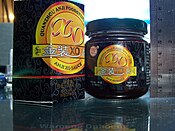XO sauce
 Rice topped with XO sauce | |
| Type | Condiment |
|---|---|
| Place of origin | Hong Kong |
| Main ingredients | dried scallop, chilli peppers, Jinhua ham, dried shrimp, garlic, canola oil |
| XO sauce | |||||||||||||
|---|---|---|---|---|---|---|---|---|---|---|---|---|---|
| Traditional Chinese | XO醬 | ||||||||||||
| Simplified Chinese | XO酱 | ||||||||||||
| Cantonese Yale | XO jeung | ||||||||||||
| |||||||||||||
XO sauce is a spicy seafood sauce from Hong Kong[1] with an umami flavour.[2] It is commonly used in southern Chinese regions such as Guangdong.
History[edit]
Developed in the 1980s in Hong Kong for Cantonese cuisine, XO sauce is made of roughly-chopped dried seafood, including dried scallops (conpoy), fish and shrimp, which are cooked with chilli peppers, onions and garlic. This dried seafood-based sauce resembles the Fujianese shacha sauce. Spring Moon, the Chinese restaurant of the Peninsula Hong Kong hotel, is often credited with the invention of XO sauce, although some claim it came from other nearby restaurants in the Tsim Sha Tsui area of Kowloon.[3]
Etymology[edit]
The name XO sauce comes from fine XO (extra-old) cognac, which is a popular Western liquor in Hong Kong, and considered by many at the time to be a chic product. The name is a misnomer since the condiment contains no cognac, and it is not really a sauce in the traditional, smooth sense, but more chunky, like a relish.[4] The term XO is often used in Hong Kong to denote high quality, prestige and luxury. Indeed, XO sauce has been marketed in the same manner as French liquor, using packaging of similar colour schemes.
Ingredients[edit]
Typical ingredients of XO sauce include dried scallop, red chilli pepper, Jinhua ham, dried shrimp, garlic and canola oil.[5] Some other recipes also call for salted cured fish and diced onion.[6]
-
An XO sauce gift pack
-
Anji Brand XO Sauce, made in China
Uses[edit]

XO sauce can be used as a table condiment or in cooking to enhance the flavour of fish, meats, vegetables, and otherwise bland foods such as tofu or noodles.
See also[edit]
References[edit]
- ^ Vos, Heidemarie (2010). Passion of a Foodie. p. 591. ISBN 978-1-934925-63-8.
- ^ Dan Holzman and Matt Rodbard (16 Dec 2015). "The Secrets of Making XO Sauce, the Magic Condiment of China". Saveur.
- ^ "XO sauce". gourmettraveller.com.au. Retrieved 2012-08-08.
- ^ Bill Daley (18 Feb 2015). "XO sauce adds luxurious flavour to Chinese New Year". Chicago Tribune.
- ^ "Flavor Ammo: Is XO Sauce the World's Most Baller Condiment?". Grubstreet. Retrieved 2012-08-08.
- ^ "Hong Kong's best condiment". CNN Go. 15 October 2010. Archived from the original on August 9, 2011. Retrieved 13 August 2012.
Further reading[edit]
- Lo, Eileen Yin-Fei (2012). Mastering the Art of Chinese Cooking. Chronicle Books. pp. 157–159. ISBN 0811878708




